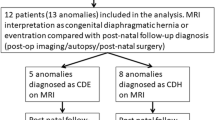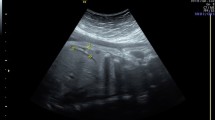Abstract
Aim
The aim of this study was to determine the development and the size and localization of the diaphragm during the fetal period in human fetuses.
Materials and methods
One hundred and eighty-four diaphragm obtained from human fetuses aged between 9 and 40 weeks of gestation was used in this study. The localization of the diaphragm with respect to abdominal cavity and the level of costodiaphragmatic recess with respect to the ribs were determined. The dimensions (height, width, and depth) of the diaphragm were measured. The diameter and localization of apertures on the diaphragm were determined.
Results
During the fetal period, the costodiaphragmatic recess was most commonly located at the level of the 9th rib. Means and standard deviations of the all parameters with respect to gestational weeks and months were calculated. No significant differences were observed between sexes for any of the parameters (P > 0.05). All parameters were increasing with age during fetal period. There was significant correlation between gestational age and all parameters (P < 0.001). The localizations of the diaphragmatic apertures did not change throughout the fetal period and aortic hiatus and oesophageal hiatus were most frequently situated to the left of the median plane.
Conclusion
New data are derived for human fetuses to evaluate diaphragmatic development. Data acquired in this study are believed to contribute to studies of obstetrics, perinatology, forensic medicine and fetal pathology on fetal development of the diaphragm, and diagnosis of its anomalies, pathologies and variations.

Similar content being viewed by others
References
Appelquist E, Hoier-Madsen K (1986) Cribriform diaphragm: a variant of congenital diaphragmatic herniation. Scand J Thorac Cardiovasc Surg 20:185–187
Babiuk RP, Greer JJ (2002) Diaphragm defects occur in a CDH hernia model independently of myogenesis and lung formation. Am J Physiol Lung Cell Mol Physiol 283:1310–1314
Becmeur F, Horta P, Donato L, Christmann D, Sauvage P (1995) Accessory diaphragm-review of 31 cases in the literature. Eur J Pediatr Surg 5:43–47
Callen PW (1997) Ultrasonography in obstetrics and gynecology, 3rd edn. WB Saunders Company, Philadelphia, Güner H. (trans. ed.) Atlas Press, Ankara, pp 375–82
Chandraraj S, Briggs CA (1991) Congenital diaphragmatic hernia through the oesophageal hiatus with nonrotation of the midgut. A case report. J Anat 178:265–272
Dietz HG, Pongratz D (1991) Morphology of the diaphragmatic muscle in CDH. Eur J Pediatr Surg 1:85–87
Fleischer AC, Manning FA, Jeanty P, Romero R (1996) Sonography in obstetrics and gynecology principles and practice, 5th edn. A Simon & Schuster Company. Yüksel A. (trans. ed.) Nobel Press, Ankara, pp 343–501
Hines GL, Romero C (1983) Congenital diaphragmatic hernia in the adult. Int Surg 68:349–351
Johnson D, Shah P, Collins P, Wigley C (2005) Thorax. In: Standring S, Ellis H, Healy JC et al (eds) Gray’s anatomy, 39th edn. Elsevier Churchill Livingstone, London, pp 945–1096
Malas MA, Üngör B, Sulak O, Albay S, Evcil EH, Çetin E (2005) The rate of growth between thorax and abdomen in the fetal period. Med J Süleyman Demirel Univ 12:35–41
Marino T, Wheeler PG, Simpson LL et al (2002) Fetal diaphragmatic hernia and upper limb anomalies suggest Brachmann-de Lange Syndrome. Prenat Diagn 22:144–147
Moore KL, Dalley AF (1999) Clinically oriented anatomy, 4th edn. Lippincott Williams & Wilkins, Baltimore, pp 158–228
Moore KL, Persaud TVN (2003) The developing human (Clinically oriented embryology), 7th edn. WB Saunders Company, Philadelphia, pp 101–200
Oh KS, Newman B, Bender TM, Bowen A (1988) Radiologic evaluation of the diaphragm. Radiol Clin North Am 26:355–364
Rypens F, Metens T, Rocourt N et al (2001) Fetal lung volume: estimation at MR imaging-initial results. Radiology 219:236–241
Sadler TW (2004) Langman’s medical embryology. 9th edn. Lippincott Williams & Wilkins, Baltimore, pp 211–221
Schumpelick V, Steinau G, Schlüper I, Prescher A (2000) Surgical embryology and anatomy of the diaphragm with surgical applications. Surg Clin North Am 80:213–239
Walsh DS, Hubbard AM, Olutaye OO et al (2000) Assessment of fetal lung volumes and liver herniation with magnetic resonance imaging in congenital diaphragmatic hernia. Am J Obstet Gynecol 183:1067–1069
Yu J, Gonzalez S, Rodriguez JI et al (2001) Neural crest-derived defects in experimental congenital diaphragmatic hernia. Pediatr Surg Int 17:294–298
Zalel Y, Lipitz S, Soriano D, Achiron R (1999) The development of the fetal sternum: a cross-sectional sonographic study. Ultrasound Obstet Gynecol 13:187–190
Author information
Authors and Affiliations
Corresponding author
Rights and permissions
About this article
Cite this article
Malas, M.A., Evcil, E.H. & Desdicioglu, K. Size and location of the fetal diaphragm during the fetal period in human fetuses. Surg Radiol Anat 29, 155–164 (2007). https://doi.org/10.1007/s00276-007-0179-3
Received:
Accepted:
Published:
Issue Date:
DOI: https://doi.org/10.1007/s00276-007-0179-3




